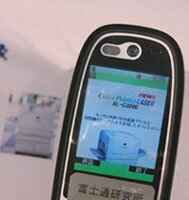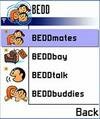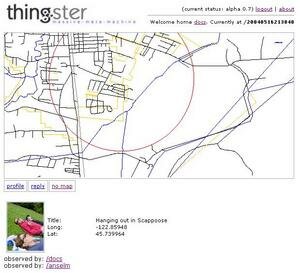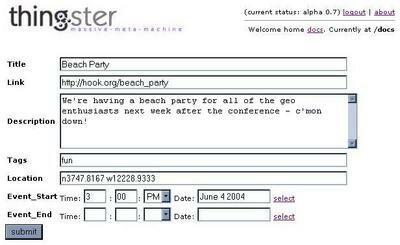July 12, 2004
Machines Reads Abstract Thought
 Pasadena Caltech researcher Richard Andersen, and his colleagues have been working on signals from brain cells involved with abstract thought, and have been able to decode them to predict body movement in monkeys' arm movements.
Pasadena Caltech researcher Richard Andersen, and his colleagues have been working on signals from brain cells involved with abstract thought, and have been able to decode them to predict body movement in monkeys' arm movements.
This development suggests that "...all kinds of cognitive signals can be decoded from patients", and the future for prosthetics for paralyzed people is optimistic. Unlike earlier research with monkeys controlling robotic arms, Andersen and his colleagues have been able to "[tap into] the messages of higher-order neurons involved in planning and motivation". It also suggests that other kinds of cognitive signals can be decoded.
[Link from betterhumans]
July 08, 2004
Raver Wearable Displays
Welcome slashdoters!
Our server is doing fine and we encourage you to check out the rest of our site. Infogargoyle is published daily.
Hufo from /. points out the following videos of this in action:
Windows Media Video 1 | Windows Media Video 2
 France Telecom has done some fun R&D to display pixelated images from your cellphone on your shirt or sleeve. These raver garments can even be used as a standalone device that can animate based on sounds and gestures. The technology uses a flexible circuit board with LEDs and other electronic bits like sensors layered in a fabric layered sandwich, which they claim is fairly comfortable.
France Telecom has done some fun R&D to display pixelated images from your cellphone on your shirt or sleeve. These raver garments can even be used as a standalone device that can animate based on sounds and gestures. The technology uses a flexible circuit board with LEDs and other electronic bits like sensors layered in a fabric layered sandwich, which they claim is fairly comfortable.
The researchers at France Telecom hope people will use these textiles to do things like display their mood, but I'd be happy if my pixilated avatar would just bop to the beat of the baseline when I'm out on the town. I really hope to see better resolution displays; this technology is still very young. With better resolution, designer memes and logos might become the hot intellectual property being shared by the young hipsters. Animated clothing is something I've been seeing a lot at Burning Man by artists with electroluminescent wire, so I have hope that this technology will encourage fashion to be more creative. For example, I would love a shirt that could display a very large "NO SPAM" message to display disgust in solicitors and peddlers in appropiate situations. I'd love to hear how others would use this creatively, so once again, I've opened up the comments
July 06, 2004
Cyborg Secret Messages
 Imagine a world where with your cyborganic rose colored glasses, you can see messages that luddites can't.
Imagine a world where with your cyborganic rose colored glasses, you can see messages that luddites can't.
Fujitsu Labs has developed some cool tech to embed 'invisible' data on your printed images. They see it as a technology to provide urls in documents so you can visit websites by photographing the document with your cellphone. That seems a bit odd though since there's no way to tell if a document has secret info in it or not.
For cyborgs with mediated reality, this could be a way to leave physical steganography in things like fliers and possibly stickers. With the ability to hide 12 characters in 1cm x 1cm, I bet the department of homeland security is going to have a panic attack.
July 02, 2004
Videoconfrencing for Working
 Very cool mac hacking, someone needs to do this for gnome/x so we can do this for our head mounted displays.
Very cool mac hacking, someone needs to do this for gnome/x so we can do this for our head mounted displays.
Makes me miss my tiny o-so-portable (and stealable) iBook. Good times.
June 24, 2004
WiFi hub using Cellular
 This product is a prototype, but I like it when common ground converges, like that of cellphone data transfer and WiFi. Well they're both WiFi really, but what this device is aimed at is bridging the gap between cellphone and hotspot communications, thus allowing more net friendly devices in stranger places. For example, I think this might be good for the Roam-Net project, when trying to teach city children about collaborative mapping and technomadics. Then again, I'd probably just get the cellphone card and build a prototype of my own with an old laptop. Bridging connections really isn't that hard after all, but this would be cool for quick temporary wireless networks.
This product is a prototype, but I like it when common ground converges, like that of cellphone data transfer and WiFi. Well they're both WiFi really, but what this device is aimed at is bridging the gap between cellphone and hotspot communications, thus allowing more net friendly devices in stranger places. For example, I think this might be good for the Roam-Net project, when trying to teach city children about collaborative mapping and technomadics. Then again, I'd probably just get the cellphone card and build a prototype of my own with an old laptop. Bridging connections really isn't that hard after all, but this would be cool for quick temporary wireless networks.
I wonder what cellphone carriers will think about open access cellphones.
June 18, 2004
Linksys 802.11g WiFi Extender

The WRE54G is a new 802.11g range extending device, similar to the Airport Express, but without as many features and about a hundred less. It extends both 802.11b and 802.11g networks, and autoconfigures with the push of a button. Doesn't weigh much either at just over half a pound.
June 12, 2004
Kim Jong-il and the Cellphone Ban
 North Korea's cellphone ban seems to be more complicated than previously stated. While the following quote from Howard Ringhold supports the censorship hypothesis for the reason behind the banning, freenorthkorea reveals that the train bombing was an assassination attempt by "anti-North Korean government forces" on the disliked leader, Kim Jong-il.
North Korea's cellphone ban seems to be more complicated than previously stated. While the following quote from Howard Ringhold supports the censorship hypothesis for the reason behind the banning, freenorthkorea reveals that the train bombing was an assassination attempt by "anti-North Korean government forces" on the disliked leader, Kim Jong-il.
 "Ohmynews is a website in South Korea that employs 26,000 citizen-reporters. Those citizen-reporters and their readers vote on which articles should appear on the front page. It's wildly popular, particularly among the young cybergeneration. Earlier this year, Ohmynews did something remarkable. The candidate that was favored by many of their readers and reporters was behind in the polls in the days before Korea's Presidential election, and the exit-polls in the early hours showed him losing. A call to action on Ohmynews led to readers sending nearly a million emails to their friends, urging them to get out and vote, along with an uncounted number of text messages to their friends' telephones. That unprecedented online get-out-the-vote effort tipped the election – and the first interview President-elect Roh gave was to Ohmynews."
"Ohmynews is a website in South Korea that employs 26,000 citizen-reporters. Those citizen-reporters and their readers vote on which articles should appear on the front page. It's wildly popular, particularly among the young cybergeneration. Earlier this year, Ohmynews did something remarkable. The candidate that was favored by many of their readers and reporters was behind in the polls in the days before Korea's Presidential election, and the exit-polls in the early hours showed him losing. A call to action on Ohmynews led to readers sending nearly a million emails to their friends, urging them to get out and vote, along with an uncounted number of text messages to their friends' telephones. That unprecedented online get-out-the-vote effort tipped the election – and the first interview President-elect Roh gave was to Ohmynews."
This indicates that North Korea's neighbor has recently had a change in government directly due to improvements in communication in the form of the internet and cellphones. While censoring the internet is easy, censoring text messages is almost impossible unless you restrict or outlaw cellphones.
In addition, if the the train bombing in Ryongchon on April 22 "had been conspired by anti-North Korean government forces to harm North Korean leader Kim Jong-il" the ban seems justified, at least from the view of the North Korean dictator. For someone so disliked, cellphones seem an obvious target to quell dissent.
"A North Korean official who was recently on his business trip to China said, “The North Korean National Security Agency has investigated the incident since it took place and concluded that rebellious forces had plotted the explosions targeting the exclusive train of Kim Jong-il. The security agency, in particular, gained evidence that cell phones had been used in triggering the explosion and reported to the North Korean leader that the use of cell phones should be banned for the sake of the leader’s safety.
...
A North Korea defector who crossed the border a few days ago said, “It doesn’t seem to be a temporary measure, because even handsets have been conscripted following the cell phone use ban.” “The Postal Service, which manages the cell phone business, has unilaterally conscripted handsets without offering any compensations. It's a typical example of a dictatorial state,” the defector pointed out." [freenorthkorea.net]
In any case, while North Korea's citizens are being held back in the dark ages, their government is still watching.

In related news, Italy takes the opposite approach, and spams it's hipster crowd with pro-voting text messages.
[Link from Howard Rheingold]
June 09, 2004
Ranting on Mobile Social Software
 I've been looking at social-network-with-cellphone-positioning services recently, and a really lame one recently popped up. At first I thought it was interesting, but the name was a bit daft - BEDD, and as it turns out it's technology is a bit lacking too. They alert you to your friends within range of your bluetooth, which is a bit like an alarm going off in your pants every time you start having a conversation with someone.
I've been looking at social-network-with-cellphone-positioning services recently, and a really lame one recently popped up. At first I thought it was interesting, but the name was a bit daft - BEDD, and as it turns out it's technology is a bit lacking too. They alert you to your friends within range of your bluetooth, which is a bit like an alarm going off in your pants every time you start having a conversation with someone.
On the other hand, they're doing dating too, which is something I heard back in the days of the cybiko. WiFi dating, for the hipster crowd. What do they call that anyways? Toothing? Flirtexting? How far off are the "open access" vibrating panties?

Now that I think about it, there could be a whole new market for 'rubtones'.
Updated at 12:00 on June 10th with 2nd picture
June 08, 2004
Thingster - The Massive Meta Machine
My partner, Anselm Hook has just announced our pet project to the public, so I felt it was the right time to give you the scoop on it here. Much of this project came out of my original goal for an information gathering community, which is certainly not a new concept, but the ideas were very similar to networks that other people like Anselm Hook and Brad Degraf wanted to build. I originally imagined a collaborative network of people wearing cameras, not so unlike camwhores.com, but aimed at allowing a distributed effort from the individual up at affecting change in the community.
So, in the effort to transform igargoyle into the community site it should be, it will be moving to Thingster soon, as a community site. We will be doing event calendars, as well as encouraging people to moblog in with cameraphones and other cyborg like gadgetry. Right now you can go check out Thingster, in it's alpha stage if you're curious.
Thingster is an open-source weblogging service for locative media. It is being developed by Anselm Hook, Tom Longson and Brad Degraf in association with Locative - a multi-disciplinary group of theorists, artists and engineers exploring the implications of attaching information to place.
Users can publish 'virtual post it notes' about any geographic location: a street intersection, a street address, a restaurant, a hiking trail or a geocache.
Speed and ease of use is a key feature. The time from first seeing the service to making that first post can be less than a minute.
The reward or 'exit strategy' for a project like Thingster is social and environmental. The hope is to enrich neighborhoods such that it becomes easy to discover local services at a lower cost and to create additional environmental awareness.
The hope is that people using Thingster should have a higher quality of life than people not use Thingster - they should simply be 'more fit'.
Thingster is in essence a killer web app for the semantic web- It extends the traditional ideas of blogging to include geographic information, events, photo albums, and much more.
As individuals we all benefit from tools that organize knowledge; tools that help us log our discoveries and interests, that let us share information.
 Emerging grass-roots tools for sharing geographic information have a particular value. Such tools provide individuals with a way to share their own view of the world - not a corporate, orthodox or official view with all of the rough edges removed.
Emerging grass-roots tools for sharing geographic information have a particular value. Such tools provide individuals with a way to share their own view of the world - not a corporate, orthodox or official view with all of the rough edges removed.
Grass-roots cartography - as it continues to evolve - has the potential to let individuals understand their surroundings in depth; to see the web of social, economic and environmental issues that tie their community together.
The better our local knowledge is the better our moment-to-moment decisions can be. This includes where and how we spend money, what natural resources we know of, how we use them and what volunteer, recreational and social opportunities we pursue.
Some ideal examples:
- A shopper can see that there is a local vendor of vegetables, and to see comments from other people about that persons farm, and the farming practices used.
- A weekend warrior discovers micro hiking trails not on any map that weave strands through a city otherwise divided by roads and cars... improving quality of life.
- Subtle clues surrounding some local mystery - a missing pet - or an unusual incidence of break-ins become highly elevated. People can reach out and have a louder voice.
- Destruction of old growth forest habitat would become immediately clear; visualized on a single map - and a much stronger call to action.
Tools are not there yet but are improving. As they improve individuals will have more power, awareness and hopefully wisdom. Member communities as a whole may then wiser as well; better stewarding their resources. A communities knowledge could be handed as a gift to each successive generation.
Updated at 9:30 on June 9th for clarity.
June 07, 2004
WiFi in unexpected places
Apple has announced their new WiFi device called Airport Express, which besides doing 802.11g in what looks identical to their regular AC adaptor, also does a plethora of other cool things. This guy can play streamed music if you plug in speakers may also act as a WiFi repeater, in case that signal is 'Very Low". Damn Apple, is this what you've been spending your iPod earnings on?

...and on another note:
Apple, why don't you cater to the wearable market at all?
June 03, 2004
June 02, 2004
3G Plus One = 300Mbps
 Well if mobile communications is important to you, this announcement from DoCoMo is sure to please. The figures here are amazing, an average of over 100Mbps, and they were able to achieve 300Mbps from a moving car. Unfortunately Americans won't see this for quite a while as cellphone companies in the states are behind the curve, but it is good news for cellphone users around the world.
Well if mobile communications is important to you, this announcement from DoCoMo is sure to please. The figures here are amazing, an average of over 100Mbps, and they were able to achieve 300Mbps from a moving car. Unfortunately Americans won't see this for quite a while as cellphone companies in the states are behind the curve, but it is good news for cellphone users around the world.
"The company said that the test achieved a maximum downstream data rate of 300Mbps with an average rate of 135Mbps in a car running at the speed of 30 kilometers per hour in areas 800m to 1km away from the 4G wireless base stations."
"[4G's average speed] is as at least as fast as any fiberoptic connection you can get at the moment, and means you can stream HDTV to your phone"
June 01, 2004
Airtexting
 By waving the Nokia 3220 camera phone from side to side, the LED lights of the Nokia Xpress-on FunShell light up to "write" a message that appears to float in mid-air.
By waving the Nokia 3220 camera phone from side to side, the LED lights of the Nokia Xpress-on FunShell light up to "write" a message that appears to float in mid-air.
To airtext, you type in a text like 'call me' then wave it back and forth in the air. As the phone moves, a row of blinking red lights along the top of the phone leaves the phrase trailing behind it."
Turns out a company called Wildseed has done a teen focus group on "Airtexting" with great success. Other names for this new meme are "Light messaging" or "Wave messaging"
[Link via boingboing]

